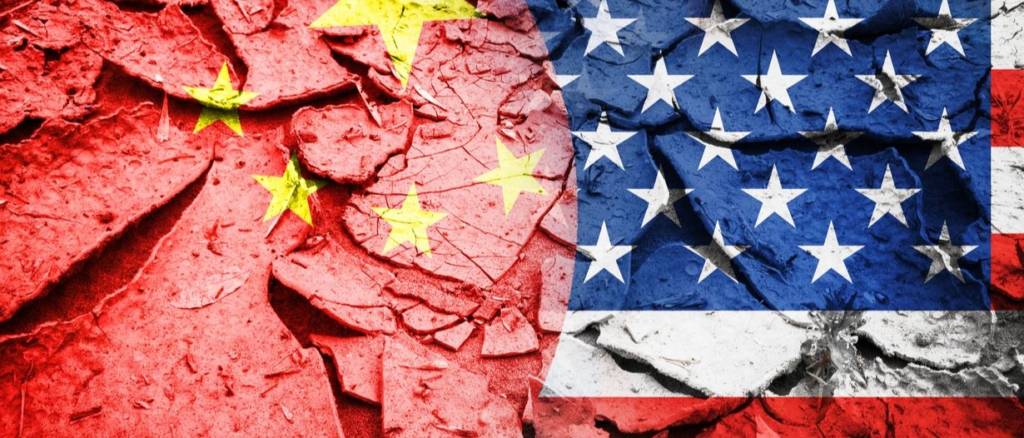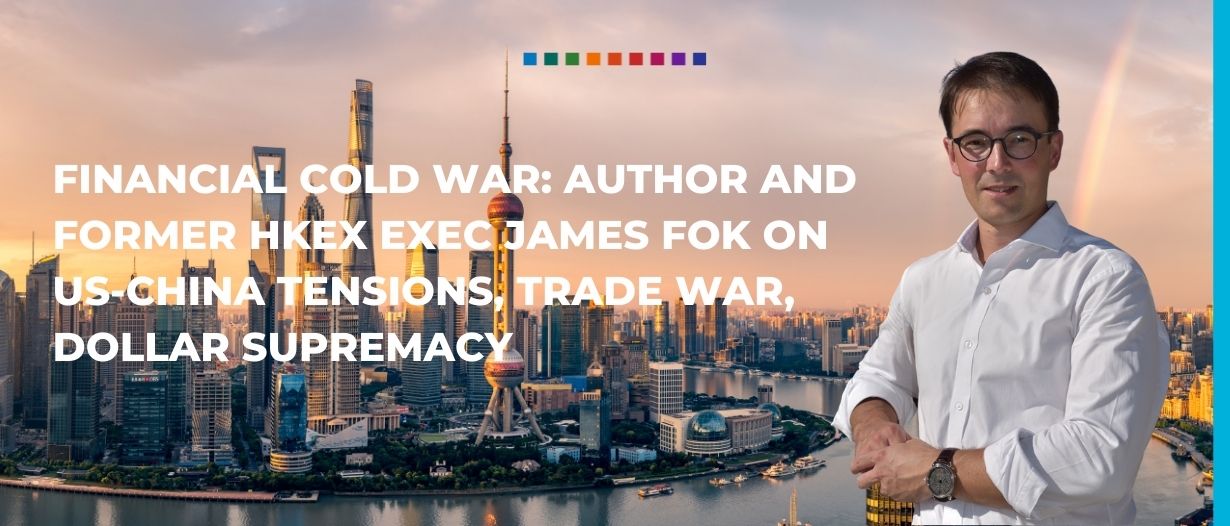James Fok is an author and a veteran financial and strategic advisor to corporations and governments.
He served as a senior executive at Hong Kong Exchanges and Clearing (HKEX) during a decade of rapid internationalisation in China’s capital markets.
Prior to that, he worked as an investment banker specialising in the financial services sector.
In this Q&A, we speak to Fok about his new book, Financial Cold War: A View of Sino-US Relations from the Financial Markets.
Can you tell us more about the title of the book, and how a “financial cold war” differs from a regular “cold war”?
The book primarily seeks to help readers understand the sources of friction between China and America.
The Financial Cold War, as I define it, is the conflict over the distribution of wealth, income, and resources, embedded in national financial policies and the structure of the global financial system.
The growing wealth and income disparities caused by the Financial Cold War have been a major driver of the increase in social tensions and international frictions, which have been spilling over into the wider conflicts we are witnessing.
Can you discuss some of the inequities and shortcomings in the global financial system that are fanning the flames of conflict between the US and China?
One of the biggest issues is the centrality of the US dollar in the global monetary system.
This system was originally introduced by the Bretton Woods Agreement at the end of World War II, and from the outset, its design was flawed.
The IMF was originally set up as a result of the 1944 Bretton Woods talks between the Allied nations. The aim was to stabilize exchange rates between nations and reduce economic uncertainty, and at first the preferred method was by tying currencies to the Gold Standard. pic.twitter.com/0jeCP6psKV
— Historic.ly (@historic_ly) January 16, 2019
As global trade and investment have surged in the decades since, it has led to a huge number of imbalances in the world economy. But the dollar isn’t the only problem.
Accompanying the globalisation of trade and financial investment, we have seen a rise in tax competition between different countries.
In many cases, this has forced governments to take on more debt to meet their spending requirements.
Since capital is much more mobile than labour (and thus more difficult to tax), it has also led to more unfair and regressive taxation, where the wealthy end up paying much lower rates of tax than middle-class workers.
These problems have been compounded by individual countries’ industrial and other policies, which have further widened inequalities.
One example of this is the steady erosion of antitrust enforcement in the US since the 1980s, which has enabled the monopolisation or oligopalisation of many industries, contributing to wage compression and lower innovation.
All of this has contributed to rising inequality, as more people have faced greater financial pressures and see prospects for themselves and their children diminishing.
Politicians in both the US and China have turned to populist nationalism, which has further fanned the flames of tensions between the two countries.
How does the dollar-centric global economy play a major role in the US-China conflict?
This is a complex issue that you need to look at from multiple perspectives, but essentially the dollar has been at the root of many of the world’s financial imbalances.
Because of widespread use of the dollar in trade and investment internationally, the US has had to continuously export more dollars to keep the world supplied with sufficient dollar liquidity.
In other words, to meet the dollar demand from around the world, the US must keep running balance-of-payments deficits.
Over the long run, if America’s economic growth doesn’t at least match that in the rest of the world, the country will end up building up ever more unsustainable levels of debt – which is where we are today.
Often, people in America accuse other countries – particularly emerging markets – of artificially holding down their currencies to “steal” US jobs.
This is true in certain cases, but it is hardly the full picture.
US industrial production and electricity consumption began peaking around the same time two decades ago.
— Lyn Alden (@LynAldenContact) November 27, 2021
That's when we accelerated our offshoring of manufacturing to China and elsewhere, which was deflationary and helped suppress domestic wages. pic.twitter.com/DzBZhfvMUS
Many governments and corporates from less developed countries have had to borrow in dollars, so currency volatility leading to a sudden depreciation of the domestic currency against the dollar has frequently made it difficult (or impossible) to repay those dollar debts, leading to bankruptcies, job losses, and a huge amount of human misery in the countries affected.
Gradually, many emerging markets started to build up huge reserves of dollars as insurance against these periodic bouts of currency volatility, particularly following the Asian Financial Crisis in 1997.
Moreover, international demand for dollars has contributed to a structural overvaluation of the dollar, which has made US exports less competitive.
Whether this is a good or bad thing depends on what level of society you fall into.
Shareholders of large American companies that have been able to reduce costs by moving manufacturing overseas have benefited through higher profit margins.
It has also helped keep inflation for consumer goods down, enabling borrowers to borrow at lower interest rates.
However, if you are a manufacturing worker, this has generally meant job losses and wage stagnation over the past 40 years.
One of the main arguments of my book is that the dollar-centric global monetary system increasingly doesn’t serve anybody – or, at least, not the vast majority of people – well in any country.
In your book, you take a balanced approach to what is working and what is not working in both China and the US. What are the benefits of each country’s financial system?
There is no other country on earth that has the institutional capacity or willingness to serve as the liquidity provider of last resort to the rest of the world as the US.
This is precisely what the Federal Reserve stepped in to do during the 2008 Global Financial Crisis, and more recently during the COVID-19 pandemic.
Moreover, unlike the European Central Bank, which is answerable to many sovereign constituencies, the Fed can act swiftly and decisively in a crisis.
It is perhaps precisely because of the strength and competence that the Fed has demonstrated that US policymakers have become so over-reliant on monetary policy.
Federal Reserve vows "unlimited" stimulus to halt coronavirus recession https://t.co/JZDhYg1woK pic.twitter.com/i5XtWnQI0i
— CBS News (@CBSNews) March 24, 2020
However, this over-reliance has generated a whole host of imbalances, including the sharp rise in wealth disparities we have seen.
To give Chinese policymakers due credit, when Deng Xiaoping initiated reform and opening up in the late 1970s, the country was dirt poor, technologically backward, and still riven with deep conflicts.
The policies that China has pursued since have achieved spectacular results.
And while the economic planners often get a bad rap for holding back growth in the early years, their insistence on limiting China’s foreign borrowing insulated the country from the financial crises that hit many emerging markets during the 1980s and 90s.
By successfully harnessing the savings of the Chinese people to drive huge infrastructure investments, they enabled the country to achieve the level of prosperity it enjoys today.
The key challenge now is to adapt to China’s new circumstances, which require a significantly different economic growth model that makes better use of market mechanisms for pricing and allocating capital.

What are the biggest financial challenges facing the US and China today?
Both countries have borrowed heavily against future generations, not just in the form of explicit debts and unfunded pensions and social welfare obligations, but also in the form of the environmental damage their growth models have caused.
The biggest financial challenge for the US – and, frankly, all countries – is how to replace the current dollar-based global monetary system with a more sustainable alternative.
The US simply can’t go on absorbing the financial imbalances in the rest of the world.
China faces the additional challenge of a rapidly aging population, which is likely to lead to slower growth and greater social tensions.
The Chinese government has pulled out the stops to increase the birth rate and raise productivity, but the fall from around seven workers per dependent today to an estimated two workers supporting each non-working person by 2050 is going to create a lot of strains.
Animated Chart: China's Aging Population (1950-2100) ????https://t.co/zaBCD46VTR pic.twitter.com/Wnt2Pali4D
— Visual Capitalist (@VisualCap) December 28, 2021
What are some of the financial reforms that you recommend for China and the US, as well as globally?
I should first make it clear that there isn’t any silver bullet to solving the imbalances in the global financial system today.
Given how interconnected we have all become through globalisation, reforms in one country are likely to have knock-on effects on others, and there are significant risks of unintended consequences.
This is why international cooperation and coordination are critical.
The biggest collective challenge will be how to reform the dollar-based global monetary system.
Chapter 8 of my book provides a framework for thinking about possible alternatives, but as we saw with the wind-down of sterling’s role as the global reserve currency following World War II, this is a process that is likely to take a long time.
In the shorter term, to address the issue of rising wealth and income inequality, both the US and China need to adjust their tax systems to make them more progressive.
Given the challenge of global fiscal competition, they will need to work together to establish certain minimum international standards.
Last year’s G7 agreement on a global minimum corporate tax rate was a good start, but more needs to be done to give these rules teeth.
Achieving some form of wealth redistribution in America at the present time is likely to be very challenging, in view of the polarised political atmosphere.
In order to address its financial challenges, the US will inevitably need to confront issues that are undermining its democracy – in particular, the outsized influence of wealthy and corporate interests in US politics.
The key financial challenge for China will be to move away from its top-down investment-driven economic model.
This has been very successful in the past, but it is increasingly leading the country to build far too much industrial capacity.
That is not to say that the state shouldn’t play a role: markets operate on incentive structures created by rules and institutional frameworks.
But the government should focus on establishing clear laws and regulations, rather than directly intervening in capital markets.





























